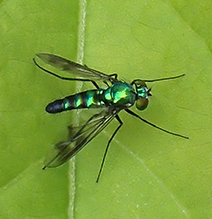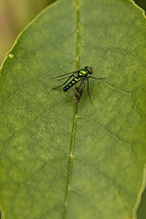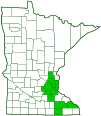longlegged fly
(Condylostylus patibulatus)
Conservation • Description • Habitat • Ecology • Distribution • Taxonomy
|
|
||||||||||||||
Description |
Condylostylus patibulatus is a common, small, long-legged fly. It occurs in the United States and southern Canada east of the Great Plains. It occurs in the southeastern quarter of Minnesota, where it reaches the northwestern extent of its range. Adults are found in woodlands and meadows near streams and swamps. Adults prey on smaller insects. Larvae live in soil or under bark and are seldom seen. They prey on small invertebrates. Adults are slender and 3⁄16″ to ¼″ (5 to 6 mm) in length. The head, eyes, thorax, and abdomen are shiny and metallic dark green, often with steel blue areas, and always with a little to a lot of copper coloration. The head, the rear of the thorax, the scutellum, and the front and rear segments of the abdomen are often steel blue. The head is broader than the thorax. The top of the head (vertex) is deeply indented. There are two large compound eyes on the sides of the head and three small simple eyes (ocelli) in a triangle on top of the head. The compound eyes are bare, with no hairs. They do not meet at the top of the head on either sex. The antennae are black and short, shorter than the head. They have just three segments. The second segment has long bristles. The third segment is small. There is a stiff, forward-pointing bristle (arista) on the upper side on the third segment. The arista is slender and moderately long, shorter than the length of the head and thorax combined. It is bare, not feather-like (plumose). The face has long white hairs. The upper part of the face (frons) has both black and pale bristles. The combination of protruding mouthparts (proboscis) is short, black, and is modified for piercing. The thorax is large and has three segments. Each segment has four principal exoskeletal plates, one above, one below, and one on each side. The upper (dorsal) plates, from front to rear, are the prescutum, scutum, and scutellum. The prescutum and the scutum are not differentiated – there is no groove between them. The sides of the thorax are black with a greenish reflection, and are slightly dusted with white, making them appear grayish. There are two longitudinal rows of black bristles on each side near the middle. The outer (dorsocentral) row has 4 or 5 strong bristles. There are two pairs of bristles on the scutellum. Both pairs are long. The small, knob-like, balancing structures on each side of the thorax (halteres) are blackish-brown or pale dingy yellow on the male. On the female, the stalk (peduncle) is brownish-black but the knob at the end is yellow. However, the halteres are covered by the wings and cannot be seen on most photographs. The abdomen is mostly shiny green. Usually the rear two segments, and often the front segment, are purplish-blue. The front margin of each segment has a narrow black band. The upper surface has black hairs. On the female the abdomen is relatively broad and abruptly tapered at the end, appearing pointed at the tip. On the male the abdomen is slightly tapered and is rounded at the tip. The genitalia on the male are large, conspicuous, and folded under the abdomen. The wings have two smoky-brown bands on the outer half, connected along the leading edge (costal margin), forming a U shape. It may be dark and well-defined, or somewhat faded and broken. Sometimes it is reduced to cloudy areas along the veins. Sometimes it is too faint to be detected on photographs. The lobe at the base of each wing (calypter) that covers the haltere is well developed. The upper surface has black hairs, though this cannot be seen without magnification. The radial sector (Rs) vein has two branches and is slightly swollen at the fork. The M2 vein is present. The M1 is sharply recurved beyond the M2. The radial-media (r-m) cross vein, a short vein between the radius and media veins, is in the basal quarter of the wing. The legs are long and on both sexes are entirely black. The fourth segment (tibia) on all legs has black bristles. On the hind legs these are small, on the upper side only, and are hard to see. The last part of the leg (tarsus), corresponding to the foot, has five segments. On the front leg the first segment is very long, longer than all of the remaining segments taken together. |
Size |
3⁄16″ to ¼″ (5 to 6 mm) |
Similar Species |
Habitat |
Woodlands and meadows near streams and swamps |
Ecology |
Season |
|
Behavior |
|
Life Cycle |
|
Larva Food |
|
Adult Food |
|
Distribution |
||
|
Sources |
|
| 6/26/2025 | ||
Occurrence |
||
|
||
Taxonomy |
|
Order |
|
Suborder |
Brachycera |
Infraorder |
Orthorrhapha |
Superfamily |
Empidoidea (dance flies, long-legged flies, and allies) |
Family |
Dolichopodidae (long-legged flies) |
Subfamily |
Sciapodinae |
Tribe |
Sciapodini |
Genus |
|
Subordinate Taxa |
|
|
|
Synonyms |
|
Dolichopus patibulatus Psilopodinus carolinensis Psilopus amatus Psilopus patibulatus |
|
Common Names |
|
No species in the genus Condylostylus has been given a common name, nor has the genus itself. The common name for the family Dolichopodidae is long-legged flies, and it is used here for convenience. |
|
Glossary
Arista
A large bristle on the upper side of the third segment of the antenna of a fly. Plural: aristae.
Frons
The upper front part of an insect’s face, roughly corresponding to the forehead.
Halteres
In flies: a pair of knob-like structures on the thorax representing hind wings that are used for balance.
Ocellus
Simple eye; an eye with a single lens. Plural: ocelli.
Scutellum
The exoskeletal plate covering the rearward (posterior) part of the middle segment of the thorax in some insects. In Coleoptera, Hemiptera, and Homoptera, the dorsal, often triangular plate behind the pronotum and between the bases of the front wings. In Diptera, the exoskeletal plate between the abdomen and the thorax.
Tarsus
On insects, the last two to five subdivisions of the leg, attached to the tibia; the foot. On spiders, the last segment of the leg. Plural: tarsi.
Tibia
The fourth segment of an insect leg, after the femur and before the tarsus (foot). The fifth segment of a spider leg or palp. Plural: tibiae.
Vertex
The upper surface of an insect’s head.
Visitor Photos |
||
Share your photo of this insect. |
||
This button not working for you? |
||
Babette Kis |
||
Condylostylus patibulatus I found this Condylostylus patibulatus, bluish long-legged fly, at a hedgerow near a tallgrass prairie in Racine Co., WI on June 26,2025. This fly was about 5 mm long. It was raining when I took the pictures. |
||
 |
 |
|
Greg Watson |
||
 |
 |
|
MinnesotaSeasons.com Photos |
||
|
||
|

Slideshows |
|

Visitor Videos |
||
Share your video of this insect. |
||
This button not working for you? |
||
|
Other Videos |
||
Colorful Condylostylus patibulatus Long-legged fly at the flea market |
About
Jun 5, 2022 |

Visitor Sightings |
||
Report a sighting of this insect. |
||
This button not working for you? |
||
| Greg Watson 6/28/2022 |
Location: Great River Bluffs State Park |
 |
MinnesotaSeasons.com Sightings |
||
|

Created: 8/7/2022 Last Updated: © MinnesotaSeasons.com. All rights reserved. |

